
|
C&S Online Confidence. Fitness. Success. |
Grandmaster Peter Rose
Rose School of Karate, Portsmouth, NH
I am proud to announce that we have 24 active and registered black belts currently operating 11 different programs. Yondan Wilkewitz weighs in with the largest enrollment, but is closely followed by Yondan Larison, and then Yondan Bushue. Good going! I guess the rest of us need to focus on a little recruiting! How about it?
I am also proud to announce the following presentation of 20 year Black Belt Certificates of Achievement. This recognition comes a little late for some and maybe just a bit early for others. I had not looked at this situation since our last (and first) all disciple gathering out here in New Hampshire several years ago. I must admit to not keeping very good records on this, and so I hope all of those who have 20 years or are close to 20 years are covered in this list. If not, would you please let me know that your 20 year anniversary went by without recognition? Same for those of you at the 25 year point- I want to be sure these milestones of black belt achievment are recognized.
But as I expressed to the Board when preparing this list, after 30 years no one will recognize you anyway because you are a "stealth warrior" by that time. Note that I said "after 30 years". We have a 30 year "hanger-on" that needs little introduction to you all: our 'wandering warrior", Sandan Carl D. Parker. I'll be sending out a plaque to Sandan Parker in recognition for his achievment. A similar plaque was presented to Dragon Master David Landers who began his training with me in the dirt back in 1970 at the Brownridge Institute of Karate. Congratulations to you both, and to the following 20 Year recipients:
- John Patterson
- Thmas Thompson
- Rose Boggs
- Kerry Bushue
- Timothy House
- Daniel Goter
- Joseph Larison
- James Namcarrow
- Brad Ulmer
Another recognition I would like to make is my long time friend and student, Nidan Charles Arlington. Charlie is from the "old school" starting with me back in 1973. Until seriously compounding an old leg injury scrambling around in the mud during one of our rather rowdy 3rd Brown exams many years ago, Charlie was very active in my school and one of my best senior instructors. He was also a large supporter of me as I took on the role of forming the association. Unfortunately, his doctor told him, "…no more karate or you'll end up dragging that leg around behind you on a string…" and forced him out of active participation. But we have stayed close all through the years; my wife and I just had dinner with Charlie and his wife Cindy. And one of the topics of conversation is always karate and how everyone is doing and what is going on. He has paid his association dues every year and is about as active as he can be, though Charlie- we would like to hear from you so our newer students know who you are! In any event, I have a very "late" 20 year certificate for Nidan Arlington to recognize him as someone who, not only benefited from the art when he was in the club, but who continues to practice that art every day regardless of where he is. And he'll tell you that he is where he is because of the art. Ask him. You should know…
As many of you know, I am still not be sure if I can make Grandmaster Dusenbery's Association Retreat in Aug of this year. My job situation was complicated (some for the better) by a recent acquisition by a much larger company in October. With that come many changes in job responsibilites, office policy, benefits- and vacation scheduling. If I am unable to make it, try to bear up under the pressure without me.
Regardless of my situation, I would hope all Program Directors will be able to make this Association Retreat. Grandmaster Dusenbery kindly offered to host this event as I had done the first one for disciples. He wanted to gather everyone together, and I thought that would be a great idea. So, I hope you can all come out and I hope you can inspire as many of your students or others in your club to attend as well. But let's try to get all the Program Directors as we need to make sure everyone in a leadership position knows that their input is critical to the strength of our association. Grandmaster Dusenbery is preparing many events and topics of discussion geared specifically for those of you in leadership positions, so take advantage of this to not only learn but to contribute as well. And there will be plenty for all other students to participate in as well. Hope to see you all there!
Grandmaster Peter M. Rose holds an 8th Degree Black Belt. He began his studies with Grandmaster S.A. Brock in 1968. He has operated the Rose School of Karate in Portsmouth, NH since 1972. Grandmaster Rose is a senior software analyst, designer, and technical project manager. Grandmaster Rose can be reached at zzrose@yahoo.com , or you can visit his personal web page at http://www.zzrose.com/pmr.html.
Grandmaster Paul Dusenbery
Boulder School of Self Defense, Boulder, CO
It is with great pride that I announce the promotion of Daniel Wilkewitz to the rank of Yondan, fourth degree black belt. He received his promotion on Saturday, October 27th at my annual Disciple Retreat that was held in Estes Park, Colorado. Very few students ever achieve this rank. It takes many years of dedication to the principles of our Art, a willingness to go beyond what is required, a thirst for knowledge, and the desire to share the Art with others. Yondans are the glue that holds our Association together. They are ambassadors of the Art, within as well as without the Association.
It is no easy feat to make it to first degree black belt in our Association. Can you imagine what it takes to make it to Yondan, fourth degree black belt? If there was an easy way for all students to achieve this level of ability and understanding than I could probably make a million bucks a year on the seminar circuit. But alas, there is no panacea that I have which will get you there except for your own fortitude and perseverance. The latter virtue is, I believe, one of the keys to success in gaining advanced rank. It is what allowed Yondan Wilkewitz to arrive at the place few individuals will ever experience. He has given much to our Art: he produced the C&S newsletter for many years, he co-developed the Chi Gung curriculum, he is the editor for our emerging black belt curriculum, and he is a great sensei. These and many other accomplishments are his legacy to the Art.
As you pursue your dreams and continue to develop your Art, remember this saying:
"The light is within thee, let the light shine".
Master Dusenbery
Grandmaster Paul B. Dusenbery, PhD holds a 7th Degree Black belt. He began his studies with Grandmaster Rose in 1972. Dr. Dusenbery is a space scientist, writer, lecturer, and is the Executive Director of the Space Science Institute in Boulder, CO. He oversees the Dusenbery Tiger leg of C&S. Grandmaster Dusenbery can be reached at dusenbery@spacescience.org.
Yondan Kerry Bushue
Personal Protection Agency, Lindale, TX
In the course of our martial arts education, we learn numerous techniques, some of which are somewhat complicated and have to be set up just right in order for them to be effective. Those techniques are useful and are very effective if done properly. This article is not about those techniques. Instead we will focus on a few simple, quick, and effective techniques that do not require a great deal of skill in order to employ and are based in probable real life situations. As a testament to the simplicity of these techniques, we had students who had never been exposed to these techniques that more or less had them perfected in ten minutes.
An example of one such technique would be an assailant grabbing your hair from the front with you standing up. This tends to happen in "real life situations" and can be painful and disorients you. In order to combat this attack, the first thing you must do is to ground the attackers hand to your head. This task is accomplished by placing your hand on top of the assailant's hand and pressing on it to keep it on your head while dropping your weight. This does two things; it keeps you from being jerked around by your hair and it helps you to keep your balance while unbalancing the assailant. Moving the attacker off balance gives you more control of the situation and the ability to react more effectively. Assailants without martial arts training would probably not realize that you are setting up for a counter-attack. In this case, defense is offense.
At this point, simply look at what you are presented with when you are in this situation. You are being grabbed by the hair from the front and probably being pulled toward the assailant. Look at the body parts of the assailant that are easily accessible. Depending on the assailant's body position, you should have the groin, knees, and feet readily accessible. A strike, or kick, to any of these areas would probably make the assailant let go of your hair so that you could either get away or follow up with another technique.
When grabbed by the hair from the front you could also strike the forearm at the elbow crease from the inside with a knife hand strike that would pull the assailant towards you. This will break the assailant down, somewhat numbing his arm which will make him release his hold. With this strike you are now in position for an elbow strike to the face
The same could be said, for a hair grab from behind. The technique would be the same (keep the assailant's hand grounded to your head) but this time twist toward the thumb side, following up with a wrist lock. You could also bring to bear a basic break technique of the bear hold from behind. That is, drop your weight, step slightly to the side and groin strike with your free hand. A groin strike is an excellent distraction as well as source of excruciating pain for the assailant. If you can maintain your balance, a stomping kick to the assailant's instep would work well also.
In a recent class, a female student presented a very good question dealing with women that have long hair and the assailant grabbing towards the end of the hair rather than close to the skull. This creates "slack" that would allow them to be pulled off balance easier. The principle is the same in this situation. You must ground yourself and the assailants hand or your hair next to your head. Probably the best way is to grab your own hair close to the skull and press down thereby preventing being jerked off balance. The techniques at that point would be the same as previously discussed.
Yondan Kerry Bushue is the Head Instructor for the Personal Protection Agency in Tyler, TX. He began his martial arts training in 1980 with Master David Landers of Effingham, Il. He moved to Orange, Texas (Southeast Texas) in 1987, and is currently living in Lindale, TX. Yondan Bushu can be reached at kdb4@etgs.com.
Grandmaster Peter Rose
Rose School of Karate, Portsmouth, NH
Generally, the Iron Broom has only been taught to those at Brown Belt level for two reasons. First, it is a very difficult technique to perform well. Second, because it is a "cool" technique, the danger in teaching it at a lower level is that it might be used in a situation when a simpler, more practical technique would have been better.
Since Master Landers introduced his "Dragon's Tail" technique, many students of all levels have incorporated it with great success into their Multiple Step Back Block and Counter drill. As the Iron Broom is simply a prone position Dragon's Tail, it would seem appropriate to at show this technique, and let each student determine their desire to go to that level of complexity.
A word of caution from the outset is to note that the Iron Broom is not intended to sweep against the opponent's forward leg as the Dragon's Tail is. The intent of the Iron Broom is to attack the opponent's rear supporting leg.
This is dangerous to practice against a fellow student without a great deal of control and readiness on the part of both students. It is a deadly technique and not to be used lightly.
In most schools, the Iron Broom is taught as an aggressive, attacking technique. However, using it in this way implies a great degree of skill and timing. This is contrary to my premise that self defense is inherently a responsive process rather than a proactive process. What I mean by this is, the more complex the technique the less likely that you will be given time in a combat situation to use it. Thus, the added skill of timing to proactively execute the technique under real conditions on the street vs. club sparring.
Pure self defense situations occur suddenly allowing no "set up" time, i.e. you don't have time to choose a technique to defend yourself with. Rather, the circumstances of the situation dictate how you are to respond. Thus, I teach "responsive" self defense: moving in response to the threat rather than against the threat.
Once in motion, I require the student to remain in motion until the threat has been neutralized. This doesn't leave time for any fancy techniques. Bear this in mind as you go through the rest of this article: I am teaching a naturally flowing response to a self defense situation that culminates in my body in a position such that I have clear access to attack the opponent's rear supporting leg. I do not create a series of moves that points to an Iron Broom. Rather, the execution of several techniques exposes an opportunity for me to utilize the strength of the Iron Broom.
I'll start my discussion with Figure 1 where you see I have done a short forward foot sweep to my opponent's forward leg. I arrived at this situation because I was grabbed by my opponent, and we tussled a little. I simply placed my left foot behind his forward heel, and did the sweep. If you move your mouse over the picture, it will tell you which figure it is. You can click on any of the figures to get a little larger size view.
Note that when I do sweeps such as this, I do not try to knock the opponent off his feet or drag his legs way apart. I'm not a very big or strong person. Rather I use the sweep to just unbalance the opponent a little and in the process I may move his foot somewhat.
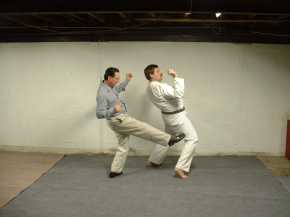
But my prime goal in doing a forward foot sweep is to pull myself around behind the opponent so I diffuse his power away from me.
That leaves me with some clear shots to the rear, which I show in Figures 2 and 3.
In Figure 2, I attack the opponent's leg I just swept with a front kick to the muscle insertion just above the knee on the back of the leg. Because I have swept this leg, the muscles are elongated and tense- perfect for a fluid shock type of kick as opposed to a snap kick.
In Figure 3, I take advantage of low-high theory and deliver an Iron Palm, palm heel strike to the back of the opponent's head. The next three figures- 4, 5, and 6- flow together as a unit.
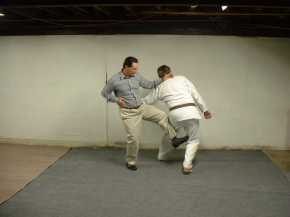
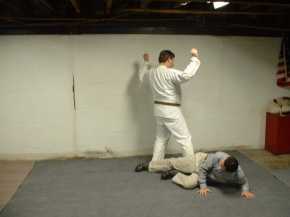
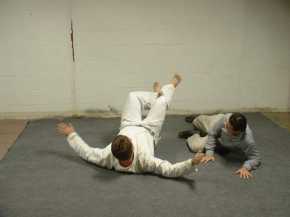
I use the fluid shock front kick shown in Figure 4 to the opponent's right inner thigh as a "step through" move. This means I am using this kick to put my body in motion in preparation to dropping to the ground in Figure 5. As you can see, Figure 4 "leads me into" the Iron Broom position. After doing the kick, my body is already leaning forward and so it is natural that I simply continue this momentum. Can you see that it is easier to just sort of "fall into" the Iron Broom position from here rather than trying to "position" myself for it back before I even got into motion in Figure 1?
Well, I could end my discussion at Figure 6. And I normally would when addressing an advanced class with this technique as most upper level students are quite capable of "filling in the blanks" from here. But if you are looking at this from the viewpoint of a beginning or intermediate student, you may be asking yourself just what you should do now that you have successfully taken the opponent down.
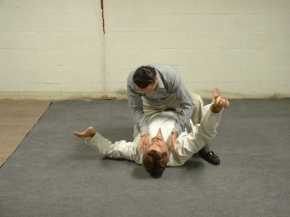
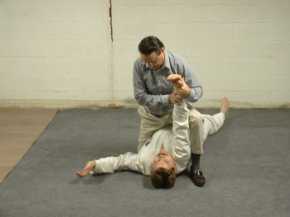
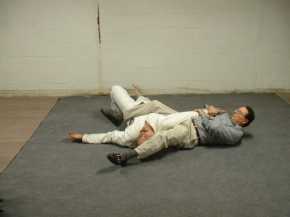
As you can see in Figure 7, I have rolled over on top of the opponent but I have not flattened out on top of him as you would expect if you were going for a body check position. Rather, I have chosen for my finish to do a cross body arm bar prefaced with double shuto strikes to the opponent's collar bone. Figure 8 shows my setup for the Cross Body Arm Bar, and Figure 9 shows the crunch.
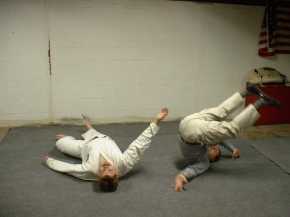
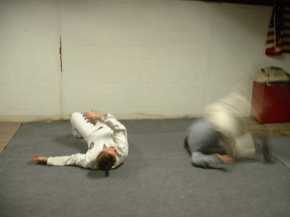

I show in Figures 10 and 11 how to back roll exit out of the cross body arm bar position, and into a cover stance over the opponent shown in Figure 12.
Grandmaster Peter M. Rose holds an 8th Degree Black Belt. He began his studies with Grandmaster S.A. Brock in 1968. He has operated the Rose School of Karate in Portsmouth, NH since 1972. Grandmaster Rose is a senior software analyst, designer, and technical project manager. Grandmaster Rose can be reached at zzrose@yahoo.com , or you can visit his personal web page at http://www.zzrose.com/pmr.html.